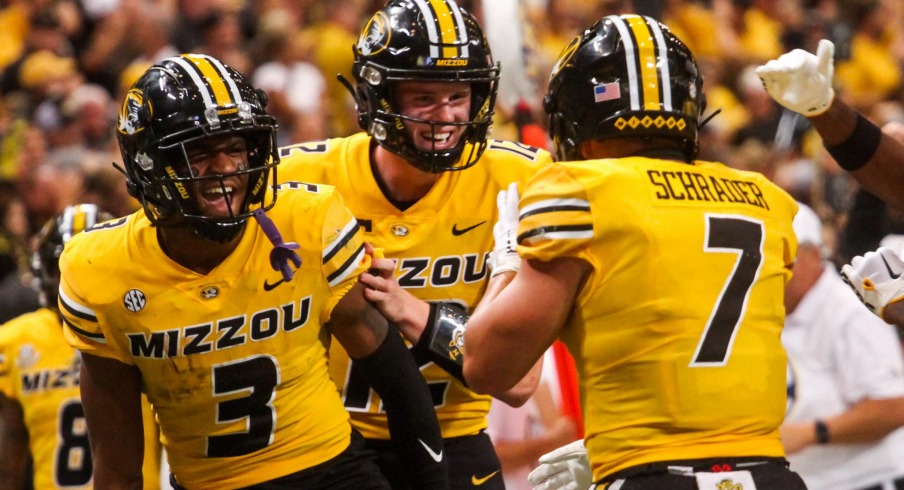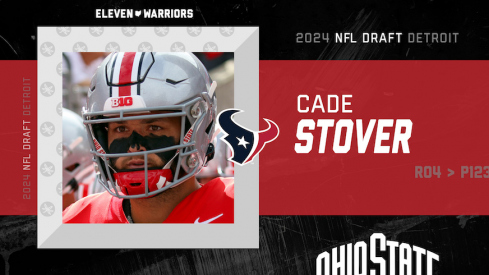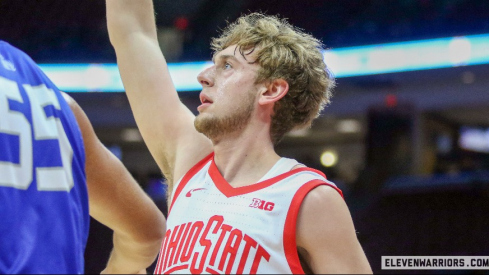"This might be the best offensive team we're going to play in terms of athletes and how they throw the ball." - Denzel Burke
Despite playing their fourth opponent ranked in the top 15 this season, members of the Ohio State defense find themselves preparing for their stiffest test yet in Friday night's Cotton Bowl matchup with Missouri. Though the Tigers only rank 23rd nationally in total offense this season, such a mark is the highest of any opponent on the OSU schedule. At 442 yards per game, the Tigers average 17 yards more than the Big Ten-leading Buckeyes thanks to a balanced attack that features All-Americans at both running back and receiver.
Led by a once 'up-and-coming' offensive mind in Eli Drinkwitz, the Tiger offense found a new gear this fall when the head coach gave up play-calling duties. In his fourth season in Columbia, the former protege of Gus Malzahn recognized the need to hand off such an arduous and important task last winter after watching the unit go in the wrong direction since he took over the program.
Now, the Tiger offense is called by a coach who makes the 40-year-old Drinkwitz look like a dinosaur. Kirby Moore may be just 32, but the brother of former Boise State star QB and current NFL offensive coordinator, Kellen, is carving out a name for himself in just his second year in charge of the Mizzou offense.
“Kirby [Moore] calls the plays,” Drinkwitz told reporters after a slow start in September led to skepticism within the fanbase. “Obviously, when it comes to in-between series, making suggestions, we all have an open traffic and talk through what we’re seeing and then what do we have to improve, [and] how can we attack them.”
After a 5-0 start and a streak of four straight weeks in which the Tigers would throw for 300+ yards, Drinkwitz's decision to hand over the headset was vindicated. But as Mizzou headed into the back half of its schedule, it became clear that Moore wasn't interested in simply finessing his way through the SEC gauntlet.
On a very basic level, the Missouri offense shares many similarities with Ohio State's. Both teams lean heavily on mid and wide-zone runs that ask the offensive linemen to move laterally while a running back with great vision and lateral quickness waits for a gap to come open.
What differs, though, is the sheer amount of ways Moore will 'dress up' such runs with motions and unique formations, such as bringing the tight end into the backfield after initially lining up in the slot and using him as a lead-blocking fullback for Cody Schrader, Mizzou's star runner.
As the clip above showed, the Missouri offensive line has blossomed under Moore's leadership. While sixth-year left tackle Javon Foster has garnered most of the acclaim with first-team SEC and third-team All-American honors, the entire Mizzou offensive line seems to move perfectly in sync when opening holes for Schrader, executing zone schemes more than twice as often as gap schemes like Counter.
"I see a lot of the same qualities," OSU defensive coordinator Jim Knowles said when asked to compare Missouri's line with that of previous opponents Notre Dame and Michigan. "I mean, they combine size and athleticism. So you have big guys who can run, who can move, understand the offense. They seem to be in the right position all the time. And that's tough to go against. I mean, they're as good as anybody we've played."
It's no surprise that Schrader prefers to run behind Foster on that left side, doing so 62% of the time this fall, yet Moore does an excellent job of using pre-snap movement to keep defenses off balance. While they rarely actually give the ball on jet sweeps, Moore uses jet motion regularly to simply pose the threat of speedster Luther Burden III taking the ball at full speed around the edge.
Such motion puts alley defenders in conflict, forced to honor the motion instead of filling a cutback lane:
But wide zone schemes like these would not be as successful without a special player taking these handoffs, and Schrader's story proves he is just that.
The St Louis native began his career at D-II Truman State, rushing for over 2,000 yards in his fourth season on campus, prompting him to enter the transfer portal and walk on at Missouri in 2022. Now, in his second season in Columbia, Schrader has broken out once again, tallying 1,499 rushing yards in Moore's offense and earning All-American honors from the AP.
His ability to jump cut before exploding upfield is truly elite, and at just 5'9" it's hard not to compare him to Blake Corum. Both players are patient enough to let defenders play themselves into trouble before juking to one side and getting north-south in a hurry.
Once in the open field, Schrader isn't going to be mistaken for an Olympic sprinter, but he constantly falls forward and picks up extra yards after contact thanks to his low center of gravity and willingness to take on contact.
That physicality carried the Tigers through the back half of their schedule, with five straight games in which he eclipsed 100 yards rushing. Now, Schrader enters the Cotton Bowl coming off his best game as a Tiger, in which he tallied 217 rush yards during a blowout win over Arkansas.
Even against the vaunted Georgia front, Schrader averaged five yards per carry. But Kentucky's aggressive defense gave him and the Missouri O-line the most trouble they’ve seen all season, often bottling him up before he could find an open gap.
The UK defensive front lined up in odd, three-man fronts throughout the game before blitzing an inside linebacker to create what was, in all practicality, a traditional four-man front. These blitzes disrupted Mizzou's zone-blocking schemes by creating unexpected double teams that kept the other inside linebacker free to mirror Schrader and make a tackle at the line of scrimmage.
While Knowles designed a similar game plan when facing Rutgers' run-heavy offense back in October, doing so against this Missouri offense is far more risky, as the Tigers have proven capable of terrorizing opponents through the air.
As mentioned earlier, the Tigers opened the season by bombing opponents through the air thanks to a strong armed quarterback and easily the best group of receivers OSU will see all year. While OSU transfer Mookie Cooper (#5) and Oklahoma transfer Theo Wease Jr. (#1) have combined for 79 catches and 1,068 yards this fall, the receiver room in Columbia is led by the All-American, Burden (#3).
While most of the Mizzou skill players have taken the long road to success via the transfer portal, the sophomore was a five star prospect coveted by every program in the country - including Ohio State. Anyone who tuned into the top-ten matchup in Athens last month could see why, even as he and the Tigers ultimately fell short in their upset bid.
Despite tight, man-coverage off the line, QB Brady Cook trusted his star wideout to win his one-on-one matchup, separating from his defender to haul in a 39-yard touchdown on Missouri’s opening drive.
“He can play. He’s a football player for sure,” Ohio State cornerback Denzel Burke said of Burden. “He can play ball.”
But while Burden clearly has the ability to take the top off the defense, Moore does an excellent job of moving him around the formation and scheming up ways to get him open, especially against heavy zone teams. For instance, he might line up in the backfield to get a free release on the line and running an underneath route between zone defenders while a teammate takes off vertically to distract the secondary.
"He's everywhere. He's as talented a guy as we have faced," Knowles said of Burden and his diversilty in alignment. "You'd better know where he is at all times. And he's in so many different places, so it makes it challenging."
Once the ball is in his hands, he becomes a nightmare for bigger, slower defenders to corral in the open field, with 719 of his 1,194 receiving yards coming after the catch. In addition to his speed and quickness, though, he is built like a running back at 5’11” and 208 lbs, allowing him to break the weaker arm tackles of defensive backs.
With Burden, Wease, Cooper, and freshman Marquis Johnson (#17) at their disposal, the Tigers primarily operate from three and four-receiver sets, spreading the field from sideline to sideline with speed. From these looks, the passing game is also similar to Ohio State’s in scheme, utilizing classing Air Raid concepts like Mesh, Four Verticals, and Y-Cross.
Much like Ryan Day has done in Columbus for years now, though, Moore and Drinkwitz rely on pre-snap alignment and movement to disguise such concepts, clearly self-scouting to keep opponents from picking up on any specific tendencies. Additionally, they incorporate tweaks like adding dual, shallow crossing routes to the classic Y-Cross concept in order to pull the linebackers up and create space for the deep over route behind them.
Ultimately, the Tigers aren’t reinventing the wheel with their downfield concepts, meaning the key to their entire scheme is the sheer volume of shifts and motions meant to manipulate the defense into being out of position. From there, the playmaking ability of numerous skill players have made a habit out of punishing defenses for doing so.
"There's a lot of motions. There's a lot of shifts," Knowles said of the Tigers' constant pre-snap movement. "So they do a great job of getting those guys free. I think that's really a big thing. They're really good, but their offense is structured to get them free through movements and shifts.”
Rarely does Kirby Smart get out-schemed, but midway through his team’s heavyweight bout with Missouri, that certainly appeared to be the case. Expecting the Dawgs on early downs to employ the Rip/Liz Cover 3 Match system made famous by Smart’s mentor and former boss, Nick Saban, the Tigers used the scheme’s rules against the defense, getting them out of position for a big gain on the first play of the second half.
With the safety rolled down toward the passing strength with both Burden and Wease lined up to the field, Burden went on a jet motion path, forcing the safeties to ‘roll’ the coverage toward the new formation strength the opposite way. This meant the corner was no longer a zone defender playing a deep-third zone to a two-receiver side, but was instead supposed to play a MEG (Man Everywhere he Goes) technique against Wease.
But the jet motion happened so quickly before the snap that the corner still played Wease’s deep corner route with a zone technique, opening his hips toward the middle of the field and getting caught flat-footed when Wease broke outside.
Of course, none of this design matters without a QB capable of delivering the ball. Luckily, Cook has blossomed in Moore’s system, throwing for 3,189 yards in 12 games during his redshirt junior season. As his throw to Burden in the Georgia game showed, he’s got a big arm with good accuracy downfield, earning his Pro Football Focus grade of 92.8 (out of 100) on throws of 20+ yards or more.
In addition to a big arm, Cook has displayed an ability to make plays with his feet as well, turning broken plays into numerous big gains. When removing sacks from his rushing total, the QB racked up 353 yards on the ground to go with 8 touchdowns, earning the attention of Ohio State defenders.
“They’ve got threats all over the field,” OSU safety Sonny Styles said of the dynamic Missouri attack. “Running back is really good, receivers are really good. I think it’s huge in college football when you see a quarterback able to extend plays and run. (Cook) is a run threat, so I think that makes the offense even more dangerous.”
However, many of those scrambles come after making just one read before tucking the ball to run, rather than work through multiple progressions with patience from the pocket. This one-read mentality has also led to multiple turnovers, especially against better opponents that bait him into throws that aren’t there.
LSU, Kentucky, Georgia, and Tennessee all possessed the athletes to break on his passes, resulting in interceptions that ultimately cost the Tigers one loss (LSU) and sealed another (Georgia).
While Cook and co. ultimately held on to beat Kentucky, Cook locked onto Burden as he and Wease ran a Post/Wheel route combination in that game, thinking he was seeing man coverage from the defense. But the Wildcats were actually in a Cover 3 Match scheme that saw the cornerback pass off Wease’s post route to the dropping alley defender before playing the pass.
Cook stared down his receiver throughout the entire play, allowing the defender to easily break on the ball.
If opponents are able to take away Cooks primary read, he becomes a very different player, drifting out of the pocket and trying to make something happen - a problem only exacerbated when he senses pressure. While trying to lead the comeback late against Georgia, this loss of fundamentals led to one of the worst interceptions you’ll ever see, throwing the ball directly to a defensive linemen while trying to evade pressure and find his tight end underneath, icing the game for the Bulldogs.
“We want to go out there and make turnovers. That’s what my mind is on,” Ohio State nickelback Jordan Hancock said earlier this month as he and his teammates began preparing for this matchup. “Getting an interception, getting a forced fumble, something of that kind.”
But while Hancock and his teammates in the secondary will surely be looking to make plays on the ball - something they haven’t been known for despite having the best pass defense in American this fall - they’ll need a big game from the OSU defensive front. Not only must the Buckeye front four force double teams in the run game, freeing up linebackers to meet Schrader at the line of scrimmage, but they must bring pressure to force Cook into bad decisions.
In their effort to avoid giving up big plays, the Buckeyes rarely blitzed this season, putting the onus on that highly regarded defensive line to earn their accolades. While that approach was largely vindicated by a ranking as one of the nation’s stingiest defenses, Ohio State has not had to deal with as many playmakers as they’ll see in AT&T Stadium.
The Missouri offense features a host of talented skill players behind a solid, well-coached offensive line. But, as is the case in most games at this level, the battle may be decided by the quarterback position, and Ohio State’s ability to make Brady Cook’s life difficult for all four quarters.



